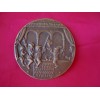Hitler Putsch Medallion # 2321
Hitler Putsch Medallion # 2321
Adolf Hitler, then aged 34, led several hundred of his most devoted followers thru the streets of Munich this evening to a beer hall where he planned to instigate a national revolt to overthrow the German government. Hitler felt these men were responsible for the shameful defeat in the Great War and Germany's further decline with the acceptance of the Treaty of Versailles. Hitler, a vehement nationalist was determined to contribute to Germany's rebirth even if it meant he himself had to undertake this great mission on his own. His plan was to coerce Munich's most influential politicians into support (at gunpoint if necessary) and then take the fight to Berlin to seize control of the government. Across the city, Nazi's were to simultaneously assail other officials convincing them of the inevitability of the coup and add them to the groups numbers. While Hitler was able to successfully win over those in his audience, the Nazi's in other locations were not. In this confusion Hitler left, presumably to intervene, at which point the politicians who were swept up by Hitler and his message began to renege on their commitments to him. By the next morning the attempted overthrow had failed. In a last ditch effort to rally his followers, Hitler and his SA Stormtroopers began a defiant march which ultimately led them to the Feldherrenhalle and a confrontation with the Munich police who were there to put down this "treasonous" uprising. Dispute continues about which side fired first, but shots rang out by both groups and blood was shed. Hitler was injured in the exchange and Hermann Göring was actually shot (he was immediately administered first aid by a Jewish family and repaid his gratitude by favorable treatment during later resettlement). The blood spilled that day ended up staining the flag that was carried, which later became Nazism's most holy relic and was forever known as the 'Blutfahne' or 'Blood Flag'. So sacred was this flag to Nazi spiritualism that it was used personally by Hitler to consecrate every Standarte for the duration of the Reich.
At any rate the crowd dissolved, the Putsch failed, and Hitler was taken into custody days later. He chose to defend himself during the trial and used the trial and its publicity to make a name for himself and win favor to his cause across the nation. Rather than accelerate his demise, this actually made him a national figure and a minor celebrity. During his time in prison for his role in the uprising, he wrote his book Mein Kempf and upon his release vowed a commitment to a legal path to power. By using a detested democracy against itself, he relentlessly campaigned until his Nazi Party became the majority party in Germany, and the rest is history. Once in power, he turned November 9th into a national holiday and personally attended commemorative marches thru its original path until the end of the Reich. Hitler never forgot those who risked their own freedom and lives to be with him on that date, and valued the "Alte Kampfers" until his end. November 9th tribute pieces, then and to this day are highly valued due to their significance as a defining prelude to the most historic events of the 20th Century. The Blood Order, perhaps the most important National Socialist political award is a result of this episode. Far rarer is this medallion.
Extremely rare to find this Karl Goetz medallion shown in the Colbert-Hyder book, C-1.
Front shows standing figures of Hitler with a pistol and von Kahr to the right of the podium. The inscription reads, "NATIONAL GEN NATIONAL!!!" (National against National). To the left of Hitler is a backwards swastika and the date "8/NOV./1923". On the podium is von Kahr's name, "V.KAHR".
Reverse shows puppets on a theater stage with von Kahr peering from behind curtain on the right. Above are the words, "MUNCHNER THEATER" (Munich Theater). Below is a handbill with the inscription, "9.11.23 / ETZTE / VORSTELLUNG / AUF NACH / BERLIN (November 9, 1923 Last Performance off to Berlin). The correct German spelling for last is "letzte". On the handbill, the "L" in letzte is formed by the puppets leg and foot. The artist's initials, "K" and "G" are found on the either side of the handbill.
Cast in bronze, 60mm. Karl Goetz artist.
This is an absolute treasure for the serious collector of early Third Reich political history.
German Militaria
(Hitler Putsch Medallion)







